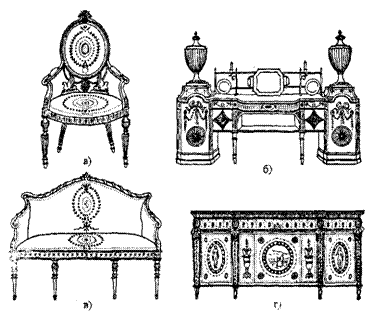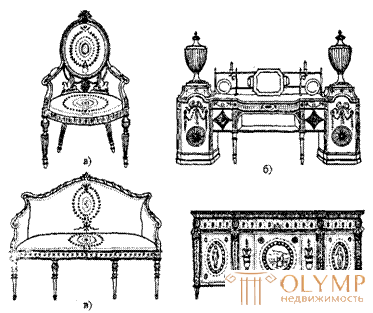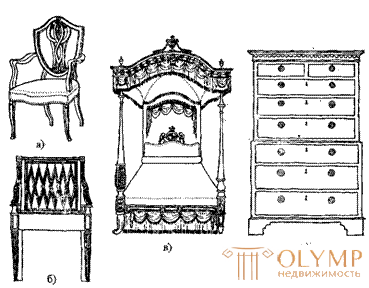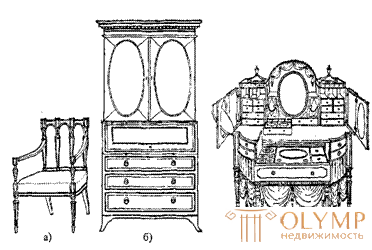
France. In the second half of the XVIII century. Rococo style fans are thinning out. Appeals for a more rational direction of art. These requirements corresponded to the new style - classicism, which revived the ancient art forms. In France, the style of classicism was established around 1770 and received the name of the style of Louis XVI. The emergence of the classical style was facilitated by the excavations carried out in Herculaneum (1738) and Pompeii (1748), the works of the historian I. Winkelman (1717-1768), the famous series of etchings “Roman Antiquities” (1748) by Italian architect and graphic artist Giovanni Baggista Piranesi (1720-1778 ), the work of the architect Jacques Francois Blondel, who in 1756 headed the Paris Academy of Architecture.
A simpler and more rigorous style of classicism more consistent with the spirit of the bourgeoisie.
With the development of classicism, the interior acquires other features, which reflects the principle of the architectural design of walls and ceilings, clearly reveals the main planes, and the decor is sparingly and subtly solved.
The style of classicism again refers to the ancient art as an ideal model. Antiquity dominates the order of architectural ensembles and the decor of the interiors.
In solving the forms of furniture products, the masters of classicism turn to samples of ancient Greece and Rome. Preference is given to straight lines, clarity and harmony of proportions prevail, decor is laconic. Antique ornamental motifs are introduced: meanders, pearl threads, acanthus leaves, oak and laurel garlands. However, the rococo style did not pass without a trace, and the ornament is enriched with realistic colors and branches.
Compared to rococo style furniture, the shape of sofas, armchairs, and chairs (Fig. 1, a, c) is simpler and calmer, the legs are straightened and are usually solved in the form of a thin slender slender column tapering downwards, covered with flutes, in which the thinnest bronze garlands run, sometimes wrapped around around the legs. The armrests also straighten and often rest on volutes with an acanthus leaf.
Several types of chairs and armchairs develop: with an oval back, decorated at the top with a garland symmetrically falling on both sides or a curl; with a quadrangular back with the upper corners cut in a concave arc with a raised middle decorated with carving, with two carved cones along the edges of the back. All wooden parts of the product are covered with rows of beads, acanthus leaves, Ionics and other antique motifs stretched in parallel. The desire to truthfully reveal the design contributed to the appearance of an almost obligatory decorative technique: the corners of the tsargos (chair seat frames) are treated as a small cube with carved rosettes inscribed into it on both sides.

Fig. 1. Furniture of French classicism: a - stup (Small Trianon), b - bureau on high supports of Riesener's work, c - gilded armchair, d - bureau with a cylindrical cover of Roentgen's work, d - chest of works by Beneman
Furniture for seating is made of carved wood, painted in light colors (white, pistachio, soft gray and blue), upholstered with striped light silk fabrics with small flowers and garlands, Chinese silk, embroidered fabrics.
Various types of furniture. The bureaus were especially popular (Fig. 1, d), the secretary with the body raised on high legs (Fig. 1, b), the dressers are still widely used (Fig. 1, e), but they become more geometric in shape. The drawers of the drawers are clearly revealed on the facade, which is facilitated by finely worked stripes and gratings, made in low relief, and lining of bronze. Toilet tables with a mirror rotating on a horizontal axis and floor mirrors on two racks appear.
In 1769, J.A. Rizener (1725-1806) invented a mechanism for folding the cylindrical cover of the bureau; since then, the bureau has been increasingly used. The famous bureau of King Louis XV was started by the teacher J.A. Riesener, J. B. Aubin. Risener placed a mechanism for folding a cylindrical lid into this bureau and performed a marquetry. The bronze ornaments were cast and minted by Duplessis.
Many furniture products, especially earlier ones, are decorated with marquetry, filled with pieces of light and dark wood. Bouquet of flowers, fluttering ribbons, shepherd flutes, and tambourines were the motifs of the set. The composition of the set was closed into a quadrilateral, a circle or an oval, outside of which a drawing imitating a grid, a checkerboard or parquet patterns was gathered. In a later period, the craftsmen abandon the marquetry and widely apply smooth mahogany veneer with a light bronze finish. Mahogany panels are inlaid with sets of various colored, often exotic woods (satin, pink, etc.). Framing perform rocks of darker shades (thuja, rosewood, ebony).
Sometimes, painted porcelain overlays, made in Sevres, near Paris, are used for the decor of the furniture, based on a manufactory founded in 1756, or ceramic plaques with white figures on a blue background, made by an English Wedgwood plant.
Mantel clocks decorated with bronze sculptural groups, candelabra, tagans standing by fireplaces, etc. are widely used. In furniture, bronze ornaments began to obey the overall composition and were performed in low relief. P. Gutier and PF Thomire were the most renowned bronze scouts of this time.

Fig. 2. The works of Adam (England): a - armchair, 6 - sideboard, c - sofa, d - chest of drawers
The art of furniture in France in the second half of the XVIIIth century. reached a high level. In Paris, along with the French, the visiting masters also worked: Aubin, Riesener, Beneman, Weisweiler. Along with Kressan and J. Jacob, they were the true creators of French furniture art. A great contribution to the development of classicism furniture was made by Georges Jacob (1739–1814), who introduced the cube motif into a furniture with a carved rosette in the place of attachment of the leg.
England. The stages of classicism in England are usually divided into the style of Adam and Heplaywhite (mid-70s) and Sheraton style (after 1790). Great influence on the development of classicism in England had an architect Robert Adam, who worked a lot in the field of interior design and published in 1776 a collection of furniture and architectural design of rooms. Furniture designs by R. Adam were of great importance for the popularization of antique motifs. Adam's furniture is characterized by the use of light wood, light proportions, clear contours, carving in low relief. Common motifs of the decor were grotesque, festoons, flower garlands, oval rosettes, sphinxes, lamb naked, mythological scenes. Typical for English furniture were the motif of a palm branch in the back of a chair and a cabinet eaves, finished with flutes.

Fig. 3. Heplaywhite works: a, b — armchairs, a four-poster bed, d - a wardrobe
According to Adam's designs, various furniture was manufactured: consoles, dressers, cabinets, glazed wardrobes, light chairs with upholstered and wicker backs of oval, round and rectangular shapes, armchairs (Fig. 2, a) and sofas (Fig. 2, c), close to antique prototypes, a sideboard (Fig. 2, b), representing a combination of a buffet and a serving table. Adam had an introduction to the furniture of the mural, which was performed by invited Italian masters (Pergolesi, Cipriani, Zukki), especially Angelica Kaufman worked in the field of furniture and interior design.

Fig. 4. Sheraton's works: a - a chair, b - a closet, c - a dressing table
The furniture of Georg Hepluite, who worked especially productively in 1775–1786, is similar in form to Chippendale’s furniture, but is distinguished by greater simplicity of form, elegance, and ease. It was made of mahogany and other light breeds; for marquetry, satin wood was widely used. The solution to the backs of chairs and armchairs is especially characteristic (Fig. 3, a, b): in form they resemble a shield and are performed either openwork or soft. The most commonly used in the backs of the chairs are three interlocking articulated arches, fan-shaped palm leaves. Heplaywhite beds (Fig. 3, c) with a canopy, held on thin racks. Cabinet furniture is simple in shape. Some products, such as dressers, are completely devoid of decor. There are numerous types of cabinets (Fig. 3, d):
Что бы оставить комментарий войдите
Комментарии (0)